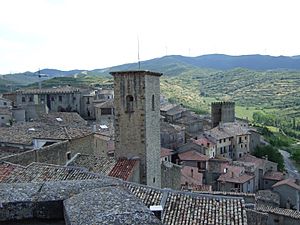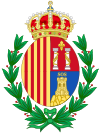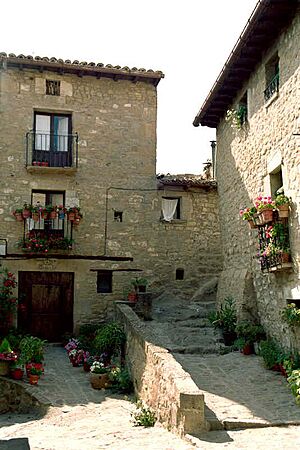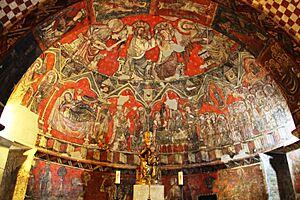Sos del Rey Católico facts for kids
Quick facts for kids
Sos del Rey Católico (Spanish)
Sos d'o Rei Catolico (Aragonese)
|
|||||||||||||||
|---|---|---|---|---|---|---|---|---|---|---|---|---|---|---|---|
 |
|||||||||||||||
|
|||||||||||||||
| Country | |||||||||||||||
| Autonomous community | |||||||||||||||
| Province | Zaragoza | ||||||||||||||
| Comarca | Cinco Villas | ||||||||||||||
| Municipality | Sos del Rey Católico | ||||||||||||||
| Founded | 907 | ||||||||||||||
| Area | |||||||||||||||
| • Total | 216.62 km2 (83.64 sq mi) | ||||||||||||||
| Elevation | 652 m (2,139 ft) | ||||||||||||||
| Population
(2018)
|
|||||||||||||||
| • Total | 588 | ||||||||||||||
| • Density | 2.7144/km2 (7.030/sq mi) | ||||||||||||||
| Demonym(s) | Sosienses | ||||||||||||||
| Time zone | UTC+1 (CET) | ||||||||||||||
| • Summer (DST) | UTC+2 (CEST) | ||||||||||||||
| Postal Code |
50680
|
||||||||||||||
|
|||||||||||||||
Sos del Rey Católico (in Aragonese: Sos d'o Rei Catolico) is a very old town and municipality in the Cinco Villas area. It is located in the province of Zaragoza, in Aragon, Spain. This town is famous because King Ferdinand II, one of Spain's most important kings, was born here.
Contents
History of Sos del Rey Católico
Sos del Rey Católico is built on a rocky, high piece of land. This made it a great place for a stronghold, which is like a strong fort.
- Early Beginnings: The town was taken back from Moorish rule in the year 907 by Sancho I of Pamplona. This was part of a long period in Spanish history called the Reconquista, when Christian kingdoms slowly took back land from Muslim rulers.
- Joining Aragon: In 1044, King Ramiro I made Sos part of the Kingdom of Aragon.
- Birth of a King: The town was originally just called "Sos." In 1452, during a civil war in the nearby Kingdom of Navarre, Queen Juana Enríquez de Córdoba came to Sos. On March 10, 1452, she gave birth to her son, Ferdinand. This baby later became Ferdinand II of Aragon, who was one of the famous Catholic Monarchs of Spain. Because of his birth, the town's name was changed to "Sos del Rey Católico," which means "Sos of the Catholic King."
- Becoming a Capital: In 1711, Sos del Rey Católico was named the capital of the Cinco Villas region.
Main Sights in Sos del Rey Católico
The old part of Sos del Rey Católico is very well preserved. Walking through its streets feels like going back in time! You can see old city walls, churches, and grand squares. The town was declared a "Historic-Artistic Grouping" in 1968 because of its amazing preservation.
Historic Buildings and Structures
- Castle of Sos de Aragón: This castle was built by Ramiro II of Aragon in the 12th century. It sits on a high point and has been changed over the years. The most important part left from the 12th century is the tall, square tower. From the top, you can see the Pyrenees mountains! The first castle here was made of wood, and the town grew around it. Later, stone replaced the wood.
- Sada Palace: This palace was built in the late 15th century in a Gothic style. It was later updated in the 16th and 17th centuries. It was built on the remains of an older castle. This is the very place where Queen Juana Enríquez gave birth to Ferdinand II of Aragon. Today, the building has a tourist office and a museum about King Ferdinand.
- Jewish Quarter: This area was very important in the Middle Ages. About 30 Jewish families lived here, arriving in the 12th century. In 1492, they had to leave Spain because of a law called the Alhambra Decree. In the heart of the Jewish quarter, you can find a square called Plaza de la Sartén. In one of the houses, you can still see a small slot where Jewish families used to place a Mezuzah. This is a special scroll with verses from the Torah. You might also see crosses carved on the doors of some houses. These marks show that Jewish families who converted to Christianity lived there.
- City Walls and Gates: Sos is built on a rocky hill and is surrounded by old Gothic walls. Because it was a border town between the kingdoms of Navarre and Aragon, these walls were very important for defense. Seven city gates, shaped like towers, are still standing today. They allow you to enter the old walled town.
- Zaragoza Gate: This is the main entrance to the town.
- Queen's Gate: This gate is named because it's believed Queen Juana Enríquez entered the town through it when she came from Navarre. It has special windows for defense and a part that sticks out for dropping things on attackers. You can also see an old carving made by French soldiers during the Peninsular War.
- Plaza de la Villa (Town Square): This is one of the most important places in Sos. It has a covered area where a weekly market was held in the Middle Ages. There's a triangular hollow called "el quesito" (the little cheese). Here, the market officer would place a scale to make sure merchants weren't cheating buyers. Next to it, there was a "barra jaquesa," a standard length measure (about 772 millimeters) that merchants used to check the length of fabrics.
- Casa de la Villa (Town Hall): This Renaissance building was built in the late 16th century. It was updated in the 19th century and restored in the 1980s to be the town's administrative office. You can see the town's coat of arms above the main door. Inside, the courtyard has a special floor made of small stones, which was common in noble houses.
- Medieval Market (Loncha Medieval): Located next to the Town Hall, this building was built around the 15th century. It was used for the large market and as a meeting place for the town council. You can still see an underground water tank and two wells that were used like refrigerators. Today, the main building houses the municipal library.
- Church of San Esteban: This Romanesque church started being built in the 13th century. It's at the top of the town. You can enter the church through a beautiful 12th-century Romanesque doorway. Inside, you can see an 8th-century baptismal font and a Romanesque statue of Christ called "Cristo del Perdón." There's also a recently restored Rococo organ.
- Crypt of Santa María del Perdón: This crypt was built in 1056 with money donated by Queen Stephanie, Queen of Navarre. It has three small chapels with old paintings that show scenes from the life of Christ, though they are in poor condition. Inside, you can also see two special stone carvings made by Master Esteban, who was one of the architects of the famous Cathedral of Santiago de Compostela. There is also a 12th-century statue of the Virgin Mary called "Virgen del Perdón."
- Hermitage of Santa Lucía: This is a small church located outside the city walls. It was built in the late 12th or early 13th century. It was originally dedicated to Saint Michael. Today, people visit the hermitage on Saint Lucia's day (December 13).
Other Places of Interest
- La Vaquilla Film Sculptures: In 2009, to celebrate 25 years since the film La vaquilla was shot in Sos, some bronze sculptures were placed in the town. These sculptures show life-size chairs used by film directors, and one sculpture of the director himself. Many local people from Sos worked as extras in this movie!
Public Services and Facilities
Sos del Rey Católico offers several services for its residents and visitors:
- Library: The municipal library is located in the old Medieval Market building. It's part of the Library Network of Aragon, so people in Sos can use books from other libraries in the network.
- Music School: Music teaching started again in Sos del Rey Católico in 2002.
- Nature Classroom: This program helps students from Aragon learn about the natural, artistic, and cultural heritage of their region. Students spend a week in Sos, learning about the town and its surroundings.
- Sports Facilities: The town has municipal swimming pools (one for fun, one for kids), a sports center with a court for different sports, and a gym.
- Toy Library: This is a special educational and meeting place just for children.
- Tourist Office: Located in the Sada Palace building, it also has a center that tells the story of King Ferdinand II of Aragon.
- Parador de Turismo: This is a special type of hotel, located in the historic center of Sos. It offers rooms, dining, and a cozy place to stay.
Other Important Services
The town also has a Post Office, a Civil Guard station, banks, a pharmacy, a 24-hour health center, a fuel station, and various hotels, bars, and restaurants.
Fiestas and Celebrations
Sos del Rey Católico has many fun festivals throughout the year:
- Bonfires of Saint Sebastian: Held on January 19–20. People light bonfires in their neighborhoods to symbolize cleaning away bad things. Neighbors gather around the fires to eat, drink, and chat.
- Ferdinand's Days: From March 4–13. These days celebrate the birth of King Ferdinand II of Aragon. Events and talks are organized around his birthday on March 10 to remember the town's most famous person.
- Valentuñana's Easter: These are the town's smaller festivals. They happen around Pentecost, usually in late May or early June. There are activities for children, dancing, music, and a special Mass at the Valentuñana Monastery church.
- Medieval Fair: Held on the first weekend of August. The streets are decorated to look like medieval times. There's a medieval market where craftspeople sell handmade items like jewelry, leather goods, and food. There's also street entertainment.
- Major Fiestas: These are the town's biggest festivals, held in the third week of August. They used to be on September 14, but were moved to August for summer vacations. The festivities start with a special rocket launch from the Town Hall. For five days, the town is full of events like bull runs (with young heifers), parades, and contests.
- Day of the Cross: September 14. This day remembers the old patron saint festivals. A special Mass is held at the San Esteban church, followed by a community meal and other fun activities.
Other Towns in the Municipality
The municipality of Sos del Rey Católico also includes these smaller towns:
- Barués
- Campo Reyal
- Castiello Barués
- Mamillas
- Novellaco
- O Reyal
- Sofuentes
Images for kids
See also
 In Spanish: Sos del Rey Católico para niños
In Spanish: Sos del Rey Católico para niños











